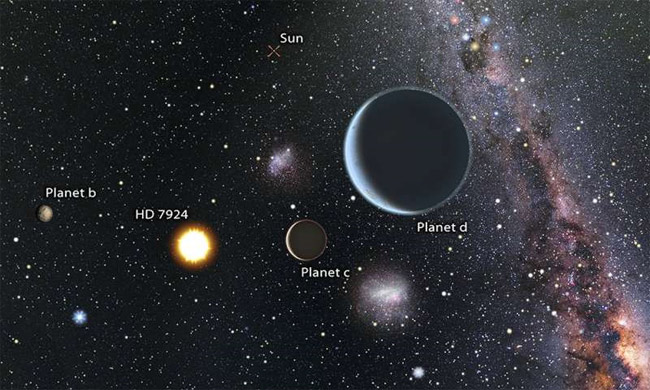Why does the star system have 3 super new Earth?
A surprisingly interesting star system found in space surprised the scientific community. The planets orbit around very close to the host star for a period of 1.2, 3.6 and 6.2 days, at the closest distance to the host star.
CfA astronomers Joseph Rodriguez, Andrew Vanderburg, Jason Eastman, David Latham, and Samuel Quinn and their team of scientists discovered that the three small planets orbiting the star GJ9827 are located relatively close to the distance 100 light years.
These three exoplanets have a radius of about 1.6, 1.3 and 2.1 times the Earth's radius respectively. All of them are classified as, that is, more massive than Earth but lighter than Neptune.

Image source: Phys.
GJ9827 is one of the lesser known stars but there are many exoplanets that often have bizarre transits with a particular atmosphere.
Not only that, the composition of these planets is expected to include rock and gas.
The planets orbiting very close to the host star for a period of 1.2, 3.6 and 6.2 days, and at the closest distances to the host star, they have a fairly hot temperature, estimated to be 898, 537 and 406 degrees C.
- Discover three new 'Super Earths' around the star LP 415-17
- Super Earth to the solar system?
- Detection of super Earth with water atmosphere
- The real planet Vulcan in Star Trek is real, super-Earth!
- Discover the planet's most planetary star
- Finding 'Super Earth' is just 6 light years away from us
- Death star bends light
- 'Super Earth' is 32 light-years away from the solar system
- Discover a new planet like the strange Earth
- Detecting the star system 'heartbeat' super strange in the universe
- Images of 'farewell kisses' of two super big, super hot stars
- Stars that can create comet rain destroy the Earth
 Van Allen's belt and evidence that the Apollo 11 mission to the Moon was myth
Van Allen's belt and evidence that the Apollo 11 mission to the Moon was myth The levels of civilization in the universe (Kardashev scale)
The levels of civilization in the universe (Kardashev scale) Today Mars, the sun and the Earth are aligned
Today Mars, the sun and the Earth are aligned The Amazon owner announced a secret plan to build a space base for thousands of people
The Amazon owner announced a secret plan to build a space base for thousands of people